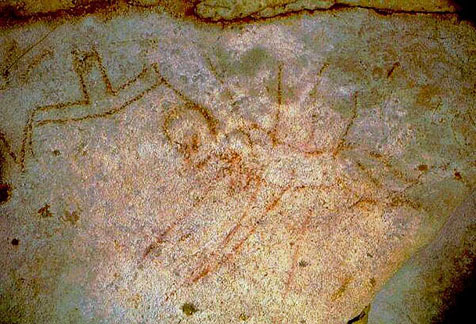
Grotte de Pech Merle (25 000 BC); Graffiti of a man killed by spears next to a “Placard Sign” after 18 000 BC
Photo Michel Lorblanchet
The Advent of Writing
5000-600 BC
“Placard Signs” in the
Paleolithic
18
000-14 000 BC
Written sings are already found in the caves of the Paleolithic as the following graffiti from the cave at Pech Merle, Lot, France shows.

Grotte
de Pech Merle (25 000 BC); Graffiti of a man killed by spears
next to a “Placard Sign” after 18 000 BC
Photo Michel
Lorblanchet
The “aviform placard sign”, an eagle, is assumed to be the emblem of a roaming group of predatory young men – the same emblem appers in other caves in the Lot area – who may have gone around killing (possibly) Neandertals. It reoccurres simplified in the collection of Vinca Script below in the 6th millennium BC.
Similar signs were used widely throughout the next 3 millenia, e.g., as oracle script in China (7000 BC) and on sacred objects elsewhere without “coagulating” into a writing system with which one could write messages in a defined language.
The Tărtăria
tablets
5300 BC

Ideograms
of the “Vinca Script”, 5300 BC
These undeciphered Vinca signs from the three Tărtăria tablets were discovered in 1961 by archaeologist Nicolae Vlassa at a Neolithic site in the village of Tărtăria (about 30 km from Alba Iulia) in Romania.The tablets, carbon-dated to around 5300 BC, bear incised symbols - the Vinča symbols - and have been the subject of considerable controversy among archaeologists, some of whom claim that the symbols represent the earliest known form of writing in the world. The small number of ideograms exclude the possibility that it represented a written language, which also makes a decipherment difficult.
Sarunas Milisauskas comments that "it is extremely difficult to demonstrate archaeologically whether a corpus of symbols constitutes a writing system" and notes that the first known writing systems were all developed by early states to facilitate record-keeping in complex organised societies in the Middle East and Mediterranean. There is no evidence of organised states in the European Neolithic, so it is likely that they would not have needed the administrative systems facilitated by writing. David Anthony notes that Chinese characters were first used for ritual and commemorative purposes associated with the 'sacred power' of kings; it is possible that a similar usage accounts for the Tărtăria symbols. Wikipedia
Early Writing Systems
3400
1000 BC
Early writing systems emerged slowly during the Neolithic and Bronze Age in several places: Mesopotamia (3400 BC), Egypt (3200 BC), and China (1600 BC) as a result of the increased urbanization, trade, and the development patriarchal kingdoms and formal religions.
Mesopotamian
Cuneiform
Sumeria,
Assyria, Babylon
3400
BC-400 AD
|
|
|
Sumerian Cuneiforms were the first to develop from an early script into an intelligible writing system. Emerging in Sumeria in the late 4th millennium BC (Uruk IV period), cuneiform writing began as a system of pictographs. In the third millennium, the pictorial representations became simplified and more abstract as the number of characters in use grew smaller from about 1,000 BC in the Early Bronze Age to about 400 BC in Late Bronze Age (Hittite cuneiform).

Development
of the Cuneiform character for “Head” (Wikipedia)
1 3000 BC, 2. 2800 BC, 3. archaic
monumental 2600 BC, 4. sign as written in clay, 2600 BC, 5.late 3rd
millenium,
6.Old Assyrian early 2nd millenium
(Hittite), 7.simplified
sign written by Assyrian scribes early 1st millenium
BC to 200 AD
The cuneiform writing system was in use for a span of more than three millennia. The original Sumerian script was adapted for the writing of the Akkadian, Eblaite, Elamite, Hittite, Luwian, Hattic, Hurrian, and Urartian languages, and it inspired the Ugaritic and Old Persian alphabets. Cuneiform writing was gradually replaced by the Phoenician alphabet during the Neo-Assyrian Empire, and by the 2nd century AD, the script had become extinct, all knowledge of how to read it was forgotten until it began to be deciphered in the 19th century.
Between half a million and two million cuneiform tablets are estimated to have been excavated in modern times. Of these, only approximately 100,000 have been published.
Literature and writing, though obviously connected, are not synonymous. The very first writings from ancient Sumer by any reasonable definition do not constitute literature. The same is true of some of the early Egyptian hieroglyphs and the thousands of ancient Chinese government records. The oldest surviving literary texts date from a full millennium after the invention of writing, to the late 3rd millennium BC. In the early literate societies, as much as 600 years passed from the first inscriptions to the first coherent textual sources: i.e. from around 3200 to 2600 BC. (Wikipedia)
Sumerian literature (2700 BC) – extant often only in Babylonian versions – includes a number of large texts: the Gilgamesh Epos (2500 BC) the Creation Myth (1600 BC), and the Great Flood (part of the Gilgamesh) are the most important. The earliest Mesopotamian literary writer known by name was an Akkadian princess, poetess, and High-Priestess Enheduanna (2289-2250 BC), who composed hymns and was an influential political figure!. The Legal Code of Hammurabi (1750 BC) (English translation) follows half a millenium later.
Egyptian
Hieroglyphs
3200BC-400AD
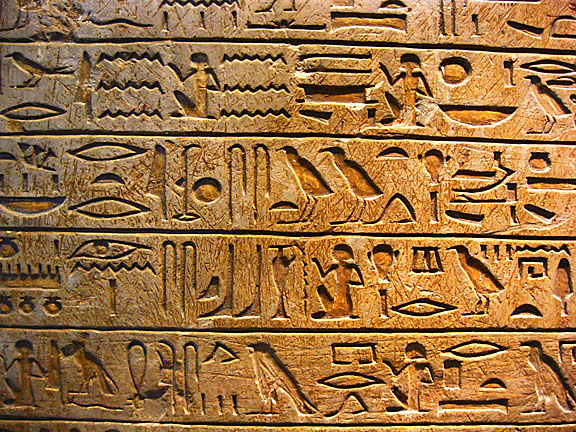
Hieroglyphs,
Louvre
Hieroglyphs were used by the ancient Egyptians on formal monuments. They combined logographic and alphabetic elements. For religious literature on papyrus and wood the Egyptians used cursive hieroglyphs. Less formal variations of the script, called hieratic and demotic, are technically not hieroglyphs.
Cursive Hieroglyphs
1250-600
BC
Cursive hieroglyphs are a variety of hieroglyphs commonly used for religious documents written on papyrus, such as the Book of the Dead. It was particularly common during the Ramesside Period and many famous documents, such as the Papyrus of Ani. It was also employed on wood for religious literature such as the Coffin Texts.
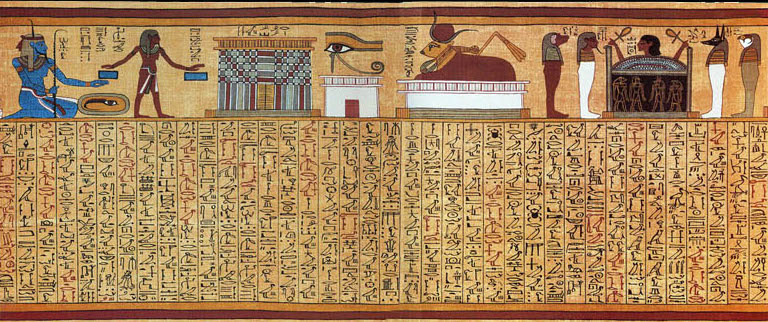
The
17th mystical “spell” of the Book of the Dead, Ani
Papyrus (1250 BC)
The vignette at the top illustrates, from
left to right, the god Heh as a representation of the Sea;
a
gateway to the realm of Osiris; the Eye of Horus; the celestial cow
Mehet-Weret;
and a human head rising from a coffin, guarded by
the four Sons of Horus
The Book of the Dead was part of a tradition of funerary texts which includes the earlier Pyramid Texts and Coffin Texts, which were painted onto objects, not papyrus. Some of the spells included were drawn from these older works and date to the 3rd millennium BCE. Other spells were composed later in Egyptian history, dating to the Third Intermediate Period (11th to 7th centuries BCE). A number of the spells which made up the Book continued to be inscribed on tomb walls and sarcophagi, as had always been the spells from which they originated. The Book of the Dead was placed in the coffin or burial chamber of the deceased.
Hieratic Script
3400-1600
BC
Through most of its long history, the hieratic script was used for writing administrative documents, accounts, legal texts, and letters, as well as mathematical, medical, literary, and religious texts. During the Græco-Roman period, when Demotic (and later Greek) had become the chief administrative script, hieratic was limited primarily to religious texts. In general, hieratic was much more important than hieroglyphs throughout Egypt's history, being the script used in daily life.
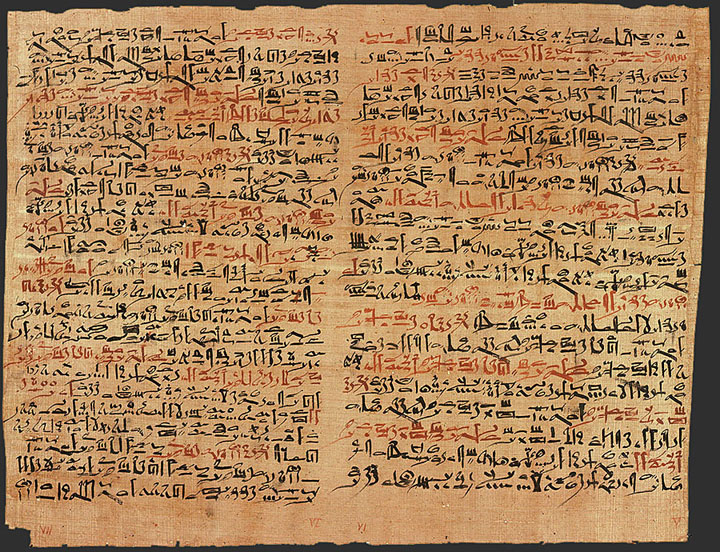
Hieratic
Text, Edwin Smith papyrus, 1600 BC
The Edwin
Smith papyrus is the world's oldest surviving surgical document.
It is written in hieratic script and describes anatomical
observations and the examination, diagnosis, treatment, and prognosis
of forty-eight types of medical problems in exquisite detail .
Among
the treatments described are closing wounds with sutures, preventing
and curing infection with honey and moldy bread (both of which are
today known to contain antibiotics), stopping bleeding with raw meat,
and immobilization of head and spinal cord injuries. Translated in
1930 (modern translation),
the document reveals the sophistication and practicality of ancient
Egyptian medicine. Wikipedia
Demotic Script
650
BC – 500 AD
Early Demotic script developed in Lower Egypt during the later part of the 25th dynasty. It is particularly found on stelae from the Serapeum at Saqqara. It is generally dated between 650 and 400 BC. During this period, Demotic was used only for administrative, legal, and commercial texts, while hieroglyphs and hieratic were reserved for other texts.
The Rosetta Stone, Ptolemaic, 196 BC
(to
enlarge click on the image)
The Rosetta Stone was discovered in 1799 by Napoleon's soldiers. It is inscribed with three scripts: the bottom is in classical Greek, the center part in Demotic, and the top in Cursive Hieroglyphs. There are 32 lines of Demotic. The Demotic was deciphered before the hieroglyphs. Eventually scholars were able to translate the Egyptian glyphs by comparing the Greek words, which could be readily translated, and the Egyptian hieroglyphs.

Business
contract in Demotic Script on papyrus, 400 BC
Between 400–30 BC during the Ptolemaic Period Greek became the administrative language of the country and Demotic lost most of its legal power. The last example of the Demotic script is dated to December 11, 452 AD, and consists of a graffito on the walls of the temple of Isis on Philae.
Phoenician
1600
BC-200
AD
Phoenican, which developed from Proto-Canaan writing, the first alphabetical script, is the Mother of all modern alphabetical scripts: Hebrew, Aramaic, Arabic, Greek and their ralatives and descendants. Phoenician being a Semitic language, words are based on consonantal roots that permitted omission of vowels without loss of meaning. Greek added several cosonants and vowels, other Semitic languages intoduced diacritical marks to remove ambiguities. The Phoenician alphabet's success was due in part to its phonetic nature; Phoenician was the first widely used script in which one sound was represented by one symbol. It made it easy to learn by anybody, which contributed to the loss of power of priests and scribes. Of course, the sea-faring Phoenician traveled all over the Eastern Mediterranean.

Phoenician
Abjad Script with
their phonetic equivalents, 1050 BC
The earliest alphabetical script, Proto-Sinaitic was in use since 1850 BC in the Sinai by Canaanite speakers. There are only a few short Proto-Sinaitic inscriptions known in Canaan in the late Middle and Late Bronze Age, but the script was not widely used until the rise of new Semitic kingdoms in the 13th and 12th centuries BC. The oldest known inscription that goes by the name of Phoenician is the Ahiram epitaph, engraved on the sarcophagus of King Ahiram at Byblos (1200 BC). It has become the convention to refer to this script as "Proto-Canaanite" until the mid-11th century, when it is first attested on inscribed bronze arrowheads, and as "Phoenician" only after 1050 BC.
Descendants of Proto-Canaaite and
Phoenician Abjad
scripts:
Ugaritic (1400 BC), Proto-Hebrew and Hebrew (1000
BC), Yemen-Arabic (900 BC), Syriac (700 BC) and the non-semitic
languages of Aramaic (1000 BC) and Greek (before 900 BC), etc.
Crete, the Aegean Islands, and
Mycene
1800 – 1200 BC
Early scripts from the Greek Aegean are known as Linear A and Linear B
Linear A is the undeciphered script of Minoa (Crete, Aegean Islands) (1800-1450 BC). It shares certain signs with the deciphered Linear B mixed with other ideograms. Reading the text as Linear B produces nonsense. The hypotheses are that Linear A, and hence Minoan was either a Hitto-Luwian or a semitic, i.e, Phoenician(!) language. The latter would agree with later Greek myths, which credit Cadmus of Thebes with having brought writing from Phoenicia.
Linear B has turned out to be written in an early Greek dialect, in use in Mycene, Pylos, Thebes, and in Crete after the devastation caused by the explosion of the Thira volcano (1400 BC) and the Mycenean invasion of Crete around 1200 BC.
|
|
|
Crete, the Gortyn Law
Codex
600-400 BC
Gortyn, today a small town, was the well fortified capital of Crete from before 1000 BC to 700 AD with some 300 000 inhabitants around 600 BC. It houses one of the first Greek inscriptions, the monumental, astonishingly modern Gortyn Codex of Cretan Civil Law. By comparision the Codex of Hamurabi (1750 BC) appears like an early form of the Islamic Sharia.
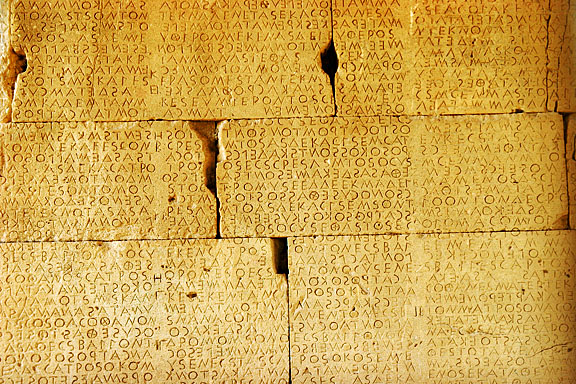
A
few blocks of the inscripton of 650 lines in boustrophedon
("ox-plough turn") writing,
running alternately left to
righ and right to left in mirrored letters
Among other civil matters the code deals with such subjects as
disputed ownership of slaves, rape and adultery, the rights of a wife
when divorced or a widow, the custody of children born after divorce,
inheritance, sale and mortgaging of property, ransom, children of
mixed (slave, free and foreign) marriages, and adoption. The code
makes legal distinctions between different social classes. Free,
serf, slave, and foreigner social statuses are recognized within the
document.
Rape under the Gortyn code is punished with fines. The
fine is largely determined by the difference in social status between
the victim and the accused. A free man convicted of raping a serf or
a slave would receive the lowest fine; a slave convicted of raping a
free man or female would warrant the highest fine.
Adultery is
punished similarly to rape under the code, but also takes into
consideration the location of the crime. The code dictates higher
fines for adultery committed within the household of the female's
father, husband, or brother, as opposed to another location. These
fines are levied against the male involved in the adultery, not the
female. The code does not provide for the punishment of the
female.
The Gortyn law code grants a modicum of property rights to
women in the case of divorce. Divorced women are entitled to any
property that they brought to the marriage, as well as half of the
joint income, if derived from her property. The code also provides
for a portion of the household property. The code stipulates that any
children conceived before the divorce, but born after the divorce,
fall under the custody of the father. If the father does not accept
the child, it reverts to the mother.
The Gortyn law code devotes a
great deal of attention to the allocation and management of property.
Although the husband manages the majority of the family property, the
wife's property is still delineated. If the wife dies, the husband
becomes the trustee to her property and may take no action on it
without the consent of her children. In the case of remarriage, the
first wife's property immediately comes into her children's
possession. If the wife dies childless, her property reverts to her
blood relatives.
If the husband dies with children, the property
is held in trust by the wife for the children. If the children are of
age upon their father's death, the property is divided between the
children, with males receiving all of the land. In the event that the
husband dies without any children, the wife is compelled to
remarry.
Adopted children receive all the inheritance rights of
natural children and are considered legitimate heirs in all cases.
Women are not allowed to adopt children. Wikipedia